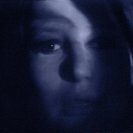(with Diane Lloyd)
three monitor installation 20:00 mins, 1981
The Sydney Studio (1981)
A Story Story was a 3 monitor piece predicated on the fact that all analogue tape decks in the era in which this tape was made (1981) ran at slightly different speeds. The three tapes all carry identical sound tracks of Dianne Lloyd relating the story of her family’s history.
The three monitors were placed side by side. The central monitor is of Dianne (head and shoulders) relating the story directly to the camera. As she speaks still slide images are projected onto her face. The monitor on the left is an image of the second monitor shot directly off the video screen but cropped so that only her eyes appear. The third monitor on the far right shows Dianne looking at the image on the central monitor on a TV set in a small kitchen. Whilst the tape progresses she rises and moves around the space to do house chores like washing up.The piece is 20 minutes long.
The three tapes begin in synchronisation but as time progresses they move slowly out of synchronisation with each other so that by the middle of the story a reverberating effect is achieved - like an echo chamber. By the end of the tape the sound tracks have become a kind of syncopated cacophony. Each screening produced slightly different effects depending on the machines being used. I was interested in how the shifting of the sound was a kind of intimate reflection of how stories do indeed get told - slightly different with each retelling. The impetus for me was also that at that time I had absolutely no information about my father’s family history prior to my grandfather’s arrival in Australia from Greece before the First World War. About my mother’s family I knew even less. I found it perplexing that Australians at that time were so keen to let go of their origins. This signified for me a lack of “depth” in Australian culture. I extended these ideas in Elementary Alphabetical.
Peter Callas
“The fact that media technology is a privileged theme in Callas’ work can be traced back to his first publicly exhibited works such as A Story Story (1981). In this three screen installation, a continuous shot of a woman narrating her own family history (central monitor) was juxtaposed with an extreme close-up showing a fraction of that image reshot from the screen (left monitor), while on the right monitor the same woman watched a replay of her original presentation. The triptych structure formally questions the viewer’s investment in the transparency of the first person ‘direct address’ to the camera on the central monitor (a prominent trope of video ‘honesty’ in the 1970s). In fact, any such investment was already placed in abeyance by the continual projection of still images of the speaker’s face and that of her grandmother back onto her visage as she spoke, producing an enigmatic (sur)face with strong surrealist overtones. The gap between the original narrative event and its representation was further heightened by the fact that, as time passed, the three video players gradually moved out of sync with each other, creating dissonance in the first person voice.”
“Interviewed in 1982, Callas argued:
I think that there’s a very interesting thing about video in relationship to time. When you present things in an installation form on two monitors or three monitors, you’re dealing very much with the present tense. It’s not as though you’re using the video screen as a window or some kind of illusionistic space into which the audience enters and forgets their surroundings. I think most of my work... is about not entering the illusionistic space, not going through the screen, but about the relationship between you and what you’re watching.”
Scott McQuire, “Electrical Storms: High speed historiography in the video art of Peter Callas”, Peter Callas: Initialising History, monograph, dLux media arts, Sydney, 1999





